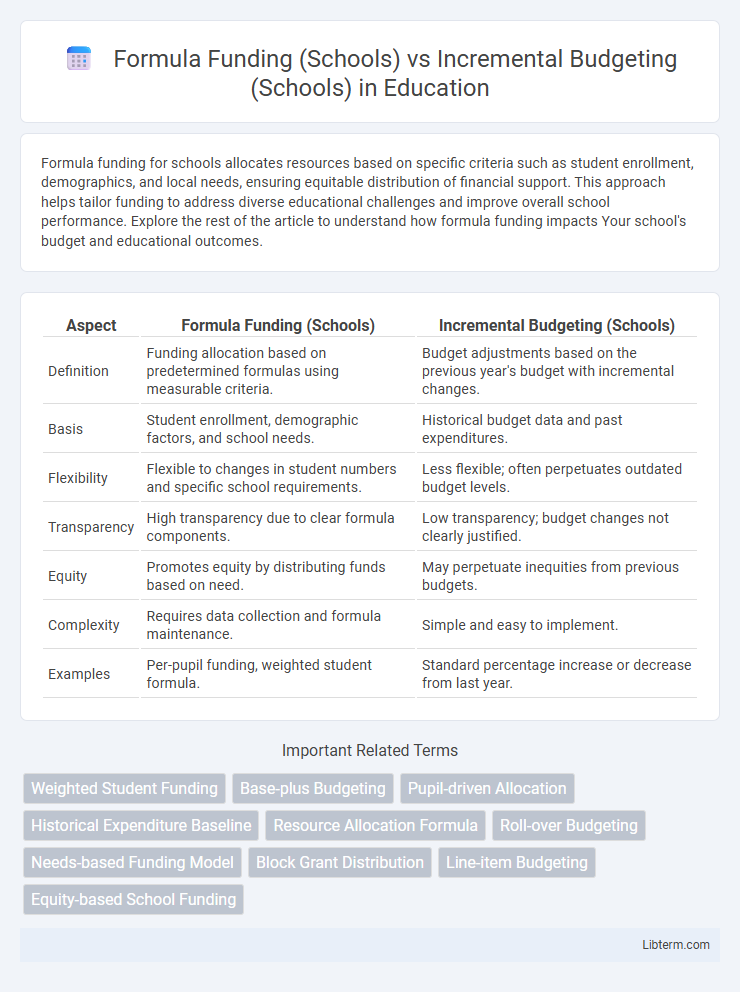Formula funding for schools allocates resources based on specific criteria such as student enrollment, demographics, and local needs, ensuring equitable distribution of financial support. This approach helps tailor funding to address diverse educational challenges and improve overall school performance. Explore the rest of the article to understand how formula funding impacts Your school's budget and educational outcomes.
Table of Comparison
| Aspect | Formula Funding (Schools) | Incremental Budgeting (Schools) |
|---|---|---|
| Definition | Funding allocation based on predetermined formulas using measurable criteria. | Budget adjustments based on the previous year's budget with incremental changes. |
| Basis | Student enrollment, demographic factors, and school needs. | Historical budget data and past expenditures. |
| Flexibility | Flexible to changes in student numbers and specific school requirements. | Less flexible; often perpetuates outdated budget levels. |
| Transparency | High transparency due to clear formula components. | Low transparency; budget changes not clearly justified. |
| Equity | Promotes equity by distributing funds based on need. | May perpetuate inequities from previous budgets. |
| Complexity | Requires data collection and formula maintenance. | Simple and easy to implement. |
| Examples | Per-pupil funding, weighted student formula. | Standard percentage increase or decrease from last year. |
Introduction to School Budgeting Methods
Formula Funding in schools allocates budgets based on predefined criteria such as student enrollment, demographics, and specific needs, ensuring equitable resource distribution aligned with educational priorities. Incremental Budgeting adjusts previous year's financial allocations by applying percentage increases or decreases, often reflecting historical spending patterns rather than current school needs. Understanding these budgeting methods is crucial for optimizing fund allocation to improve school performance and address diverse student requirements effectively.
What is Formula Funding in Schools?
Formula Funding in schools allocates financial resources based on specific student-related factors such as enrollment numbers, grade levels, and special education needs, ensuring equitable distribution across institutions. This method contrasts with Incremental Budgeting, which adjusts previous budgets by fixed amounts without necessarily reflecting current student demographics or requirements. By tying funds directly to measurable metrics, Formula Funding promotes transparency and responsiveness in educational financing.
Understanding Incremental Budgeting in Schools
Incremental budgeting in schools involves adjusting the previous year's budget by a fixed percentage or amount, simplifying the planning process and ensuring stability in funding allocation. This approach allows school administrators to maintain consistent resource distribution for staffing, supplies, and programs, minimizing disruptions in educational delivery. However, it may overlook changing school needs or efficiency improvements compared to formula funding, which allocates resources based on specific metrics like enrollment and socioeconomic factors.
Key Features of Formula Funding
Formula Funding in schools allocates resources based on specific, measurable factors such as student enrollment, characteristics, and local socioeconomic conditions to ensure equitable distribution of funds. It employs transparent, data-driven formulas that adjust funding levels according to changing student demographics and needs, promoting accountability and efficiency. This approach contrasts with Incremental Budgeting, which relies on previous budget levels and incremental changes, potentially perpetuating historical inequities and inefficiencies.
Core Principles of Incremental Budgeting
Incremental budgeting in schools operates on the core principle of using the previous year's budget as a baseline and making only small adjustments based on projected changes, ensuring stability and simplicity in financial planning. This approach emphasizes predictable, gradual funding changes aligned with historical expenditures rather than large, formula-driven reallocations. Unlike formula funding, which allocates budgets based on specific metrics or student needs, incremental budgeting prioritizes continuity and ease of administration over responsiveness to dynamic educational demands.
Advantages of Formula Funding for Schools
Formula funding for schools allocates resources based on specific metrics such as student enrollment, socio-economic factors, and special education needs, ensuring equitable distribution aligned with actual school demands. This method promotes transparency and accountability by linking funding directly to measurable criteria, allowing for more precise financial planning and resource allocation. It also incentivizes efficiency and responsiveness in school management, as funding adjusts dynamically with changes in student populations and needs.
Benefits of Incremental Budgeting for Schools
Incremental budgeting in schools offers stability by providing predictable financial allocations based on previous budgets, facilitating easier planning and resource management. It simplifies the budgeting process, minimizing administrative workload and allowing educators to focus more on teaching and learning outcomes. This method also supports gradual adjustments, ensuring continuity in school programs and mitigating the risks of abrupt funding changes associated with formula funding.
Challenges of Formula Funding in Education
Formula funding in schools often faces challenges such as inadequate reflection of local needs and disparities in resource allocation, which can lead to inequitable educational outcomes. The reliance on standardized metrics may overlook unique student populations and community contexts, causing funding gaps for schools with higher needs. Unlike incremental budgeting, which provides predictable updates based on prior allocations, formula funding risks instability and insufficient responsiveness to sudden changes in enrollment or special program requirements.
Drawbacks of Incremental Budgeting in Educational Settings
Incremental budgeting in schools often leads to resource allocation based on historical spending rather than current needs, resulting in inefficiencies and potential underfunding of critical programs. This approach limits flexibility and responsiveness, making it difficult to address changing student populations or emerging educational priorities effectively. Formula funding, by contrast, allocates resources based on specific factors like enrollment or student demographics, promoting equity and targeted support.
Comparing Formula Funding vs Incremental Budgeting: Which is Better for Schools?
Formula funding allocates school budgets based on predefined criteria such as student numbers, socioeconomic factors, and special needs, ensuring equitable resource distribution aligned with actual demands. Incremental budgeting relies on previous year's allocations with incremental adjustments, often perpetuating historical funding patterns regardless of changing school needs. Formula funding is generally better for schools as it promotes fairness and responsiveness to enrollment and demographic shifts, while incremental budgeting may lack flexibility and transparency.
Formula Funding (Schools) Infographic

 libterm.com
libterm.com